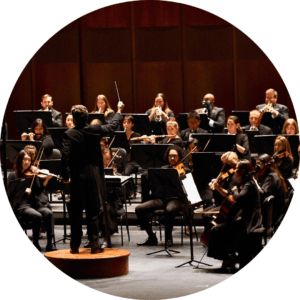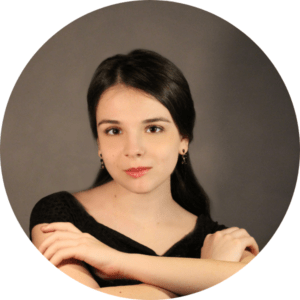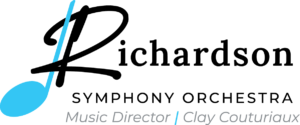
Stars of the Future: Elgar & More
ELGAR: Enigma Variation on an Original Theme, Op. 36
BRAHMS: Piano Concerto No. 2 in B♭ Major, Op. 83
Daria Podorozhnova, winner of the 2025 Ann & Charles Eisemann International Young Artist Competition
The performance is approximately 110 minutes including a 20-minute intermission after the first piece
Buy Tickets HERE
Overview
Edward Elgar’s Enigma, Variations on an Original Theme, Op. 36 are a set of fourteen musical portraits, each derived from and dedicated to different friends or acquaintances of Elgar, including his wife, musical colleagues, and even a dog named Dan. What makes these variations truly unique is the mysterious “enigma” that Elgar embedded within the music. Though he never revealed the true nature of this puzzle, it has sparked endless speculation and interpretation among scholars and listeners alike. From the majestic opening theme to the tender intimacy of the Nimrod variation, Elgar’s work takes us on a journey through a kaleidoscope of emotions. In the stirring crescendos and gentle whispers of the music, we glimpse the complexities of human relationships – the joy of friendship, the sorrow of loss, and the excitement of new beginnings.
But perhaps the true magic of the Enigma Variations lies in Elgar’s masterful use of orchestration and his ability to speak to the universal human experience. In its soaring melodies and poignant harmonies, we find echoes of our own joys and sorrows, our triumphs, and struggles. It is a testament to the power of music to transcend time and space, to touch the deepest recesses of our souls and remind us of our shared humanity. As we prepare to bring Elgar’s Enigma Variations to life on the stage, we invite you to join us on this musical journey. Let the beauty of the music wash over you and let its melodies stir your heart and soul. For in the timeless notes of the Enigma Variations, we discover the essence of what it means to be human – for music has the power to unite us all.
To conclude this remarkable program, we feature the winner of the prestigious Ann & Charles Eisemann International Young Artist Competition, pianist Daria Podorozhnova, performing Johannes Brahms’s Piano Concerto No. 2, Op. 83. This monumental concerto, known for its sweeping lyricism and virtuosic demands, is a testament to Brahms’s mastery of both grandeur and intimacy. From the bold and heroic opening to the tender, songlike melodies of the Andante, Brahms crafts a rich musical landscape that showcases both the power and sensitivity of the piano. Daria Podorozhnova’s performance promises to bring both technical brilliance and emotional depth to this beloved work, making for an unforgettable conclusion to our concert.
Program Details
ELGAR: Enigma Variations on an Original Theme, Op. 36
Theme. Andante
Variation 1. L’istesso tempo “C.A.E.”
Variation 2. Allegro “H.D.S-P.”
Variation 3. Allegretto “R.B.T.”
Variation 4. Allegro di molto “W.M.B.”
Variation 5. Moderato “R.P.A.”
Variation 6. Andantino “Ysobel”
Variation 7. Presto “Troyte”
Variation 8. Allegretto “W.N.”
Variation 9. Adagio “Nimrod”
Variation 10. Intermezzo. Allegretto “Dorabella”
Variation 11. Allegro di molto “G.R.S.”
Variation 12. Andante “B.G.N”
Variation 13. Romanza. Moderato “***”
Variation 14. Finale. Allegro “E.D.U.”
Length: c. 30 minutes, including 15 seperate sections (followed by a 20-minute intermission)
Composer: Edward William Elgar was born June 2, 1857 in Broadheath, Worcestershire, England and died February 23, 1934 (age 76) in Worcester, England
Composed: 1898-1899
What else happened in 1898-1899?
- Spanish-American War
- Rudolf Diesel (Germany) obtains patent for the diesel engine
- Marie Curie discovers radium
- Scott Joplin granted copyright for “Maple Leaf Rag” composition
- African-American inventor Issac R. Johnson patents the bicycle frame
Brahms: Piano Concerto No. 2 in B Major, Op. 83
Performed by the winner of the 2025 Ann & Charles Eisemann International Young Artist Competition: Daria Podorozhnova.
I. Allegro non troppo
II. Allegro appassionato
III. Andante
V. Allegretto grazioso
Length: c. 50 minutes
Composer: Johannes Brahms was born May 7, 1833, in Hamburg, Germany, and died April 3, 1897 (age 63) in Vienna, Austria.
Composed: 1878-1881
What else happened in 1878-1881?
- Thomas Edison patents the phonograph (1878)
- First commercial telephone exchange opens in New Haven, Connecticut (1878)
- Gilbert and Sullivan’s The Pirates of Penzance premieres (1879)
- The first electric streetlights are installed in the U.S. (1880)
- Clara Barton founds the American Red Cross (1881)
For more information on the Ann & Charles Eisemann International Young Artist Competition, CLICK HERE
Performers

Just north of Dallas and nestled in the vibrant city of Richardson, Texas, the Richardson Symphony Orchestra (RSO) embodies the essence of what it means to be a regional symphony orchestra. Led by Maestro Clay Couturiaux, the RSO’s journey is a testament to unwavering dedication and musical excellence.
Since its founding in 1961, the RSO has remained steadfast in its mission to enrich lives through the transformative power of music. From enchanting renditions of classical staples to daring explorations of contemporary works, the orchestra’s repertoire mirrors the rich tapestry of human emotion and experience.
The symphony has captivated audiences with electrifying performances, seamlessly blending precision and passion. Under Maestro Couturiaux’s guidance, each note resonates with soul-stirring depth, leaving listeners enraptured.
Beyond the concert hall, the RSO is a beacon of community engagement, nurturing young talent and enriching lives through the transformative power of music. With every crescendo, the orchestra reaffirms its status as a cultural gem, enriching the tapestry of the city of Richardson and beyond with symphonic splendor.

Daria Podorozhnova, piano
Daria Podorozhnova was born in Rostov-on-Don, Russia. She was 6 years old when she started playing the piano in a Special Music School affiliated with the Rostov State Conservatory. Her musical path began in the class of music teacher Inna Serebryanskaya.
In 2017 Daria started studying in the class of renowned professor of the Rostov State Conservatory Sergei Osipenko. In 2019 Daria became the winner of III prize of the V International Music Competition for young pianists “Astana Piano Passion”, when she was 15. Some years later she became the winner of the II International Music Competition “Rachmaninoff’s legacy” in Rostov-on-Don and I International Music Competition for young pianists “New Generation” in Moscow.
Daria has performed across Russia and abroad as a solo recitalist and in concertos, with orchestras including Rostov Symphony Orchestra, Krasnodar Premier-Orchestra, Astana Symphony Orchestra, Irkutsk Symphony Orchestra and Volgodonsk Symphony Orchestra. Daria has been invited to participate in numerous music festivals, including the “Stars on the Baikal” in Irkutsk and “The XVII International Piano Festival “Mariinsky” in St. Petersburg. In March 2024 Daria was awarded the 6th prize of 69th Maria Canals International Competition in Barcelona. In May 2024 Daria performed as a pianist in “La Traviata” production at Staten Island. Very recently in January 2025 she won the 1st prize of Ann & Charles Eisemann Young Artist Competition in Dallas, USA and was honored to perform with Richardson Symphony Orchestra as a guest artist in the Spring 2025.
Since September 2022 Daria is studying for a bachelor’s degree and working with Alexandre Moutouzkine at Manhattan School of Music, where she has been awarded a Harold and Helene Schonberg Pianist Scholarship.
Daria won the 2025 Ann & Charles Eisemann International Young Artist Competition on January 11th, 2025. She perform her competition concerto, Brahms’ Piano Concerto No. 2 in B Major alongside the RSO on March 1st, 2025.
For more information on the Ann & Charles Eisemann International Young Artist Competition, CLICK HERE
Extras
Enigma Variation Program Notes from Edward Elgar
Below are the identities of the people portrayed in the movements of Elgar’s Enigma Variations with director quotes from the composer:
Theme: This is a simple three-part design, something you could represent as A-B-A, and, in the words of Elgar’s biographer Diana McVeagh, “as productive as a goldmine.”
Variation 1 (C.A.E.): This is Alice Elgar, whose death in 1920 brought the composer’s creative life to a halt for twelve years until he began work on his Third Symphony toward the end of 1932. “The variation is really a prolongation of the theme with what I wished to be romantic and delicate additions; those who knew C.A.E. will understand this reference to one whose life was a romantic and delicate inspiration.”
Variation 2 (H.D.S-P.): Hew David Steuart-Powell was a pianist with whom Elgar, a violinist, played chamber music. Their usual cellist was Basil Nevinson (Variation 12).
Variation 3 (R.B.T.): “Has reference to [Richard Baxter Townshend’s] presentation of an old man in some amateur theatricals—the low voice flying off occasionally into ‘soprano’ timbre.” Townshend was a classicist at Oxford and rode through that town on his bicycle, the bell constantly ringing. The violins’ plucked strings and their woodwind doublings represent the bicycle bell.
Variation 4 (W.M.B.): William Meath Baker, “a country squire, gentleman and scholar. In the days of horses and carriages it was more difficult than in these days of petrol to arrange the carriages for the day to suit a large number of guests. This Variation was written after the host had, with a slip of paper in his hand, forcibly read out the arrangements for the day and hurriedly left the music-room with an inadvertent bang of the door.”
Variation 5 (R.P.A.): Richard Penrose Arnold, son of the literary critic and poet Matthew Arnold, was “a great lover of music which he played (on the pianoforte) in a self-taught manner, evading difficulties but suggesting in a mysterious way the real feeling. His serious conversation was continually broken up by whimsical and witty remarks.” Strings, in one of Elgar’s most expansive and inspired melodies, represent Arnold’s nobility of mind and his deeply truthful way of playing music.
Variation 6 (Ysobel): This is Isabel Fitton, an amateur violinist who, to make up for a shortage of violists in the neighborhood and to be obliging, switched to the deeper instrument. The music conjoins formality and gravity with discreet romantic allure.
Variation 7 (Troyte): Arthur Troyte Griffith, an architect, was one of Elgar’s most intimate friends. “The uncouth rhythm of the drums and lower strings was really suggested by some maladroit essays to play the pianoforte; later the strong rhythm suggests the attempts of the instructor (E.E.) to make something like order out of chaos, and the final despairing ‘slam’ records that the effort proved to be in vain.”
Variation 8 (W.N.): This variation, named for Winifred Norbury, is less a portrait of Miss Norbury than of Sherridge, the eighteenth-century house where she lived with her sister Florence. “The gracious personalities of the ladies are sedately shown.” As the variation draws to a close, Elgar offers the most beautiful harmonic stroke in the Enigma Variations. As the final G major chord dies away, only the first violins hold their note—G—until the other strings, re-entering, with magical effect slip a chord of E-flat major under it. And there, in a new world, begins. . .
Variation 9 (Nimrod), the most loved of the variations: “Jaeger” is the German for “hunter,” and Nimrod is the “mighty hunter” mentioned in Genesis 10. August Jaeger was a German-born musician of frail health and great soul who worked for the London music publishing house of Novello and who, more than anyone except Alice Elgar, sustained the composer through his frequent and severe periods of depression. “The Variation . . . is the record of a long summer evening talk, when my friend discoursed eloquently on the slow movements of Beethoven, and said that no one could approach Beethoven at his best in this field, a view with which I cordially concurred.” Jaeger, still young, died in 1909, and nearly twenty years later Elgar wrote: “His place has been occupied but never filled.”
Variation 10 (Dorabella—Intermezzo): Dora Penny, step niece of Variation 4 (Billy Baker), cheerful and music-loving, was a woman to whom Elgar was very close. We hear a suggestion of the stammer with which she spoke in her youth. We also sense an extraordinarily potent though repressed sexuality, to say nothing of Elgar’s powerful and repressed response to it.
Variation 11 (G.R.S.): The initials belong to George Robertson Sinclair, organist of Hereford Cathedral, but the music belongs to Dr. Sinclair’s dog. In Elgar’s words, “The first few bars were suggested by [the] great bulldog Dan (a well-known character) falling down the steep bank into the River Wye (bar 1); his paddling up stream to find a landing place (bars 2 and 3); and his rejoicing bark on landing (second half of bar 5). G.R.S. said ‘set that to music.’ I did; here it is.”
Variation 12 (B.G.N.): “The Variation is a tribute to a very dear friend [Basil Nevinson] whose scientific and artistic attainments, and the wholehearted way they were put at the disposal of his friends, particularly endeared him to the writer.”
Variation 13 (***Romanza): The asterisks in place of initials suggest further mystery, and the additional title of “Romanza” heightens the effect, as does part of the music itself. The variation starts harmlessly enough, and sweetly, but after only a few bars its course is interrupted by a strange rocking figure in the violas, which, with a soft drumroll, forms the background for a clarinet playing a phrase from Mendelssohn’s Calm Sea and Prosperous Voyage Overture. Elgar explains that the asterisks take the place of the name of a lady who was, at the time of composition, on a sea voyage. The lady was Lady Mary Lygon of the Worcestershire nobility, in the spring of 1899 on her way to Australia with her brother, who was to be installed as Governor of New South Wales. The music conveys a poignant sense of longing for someone far away.
Variation 14 (Finale: E.D.U.): These initials don’t belong to anyone specifically, but when combined, they form Alice’s affectionate moniker for Edward. This variation or finale highlights the composer’s assertive and confident demeanor, representing just a fraction of his full character. Alice and Nimrod make a reappearance, leading the music to conclude in a fiery climax.

